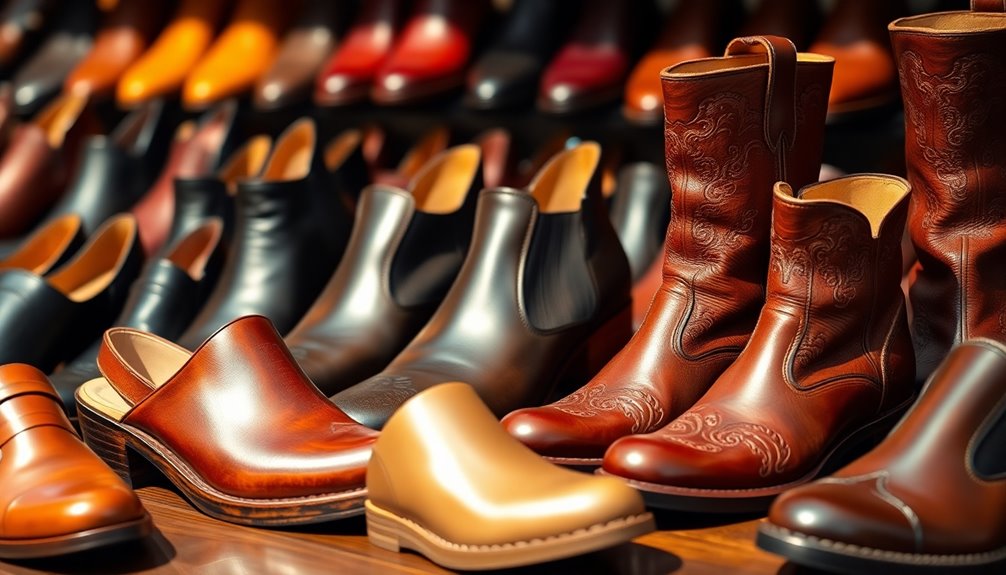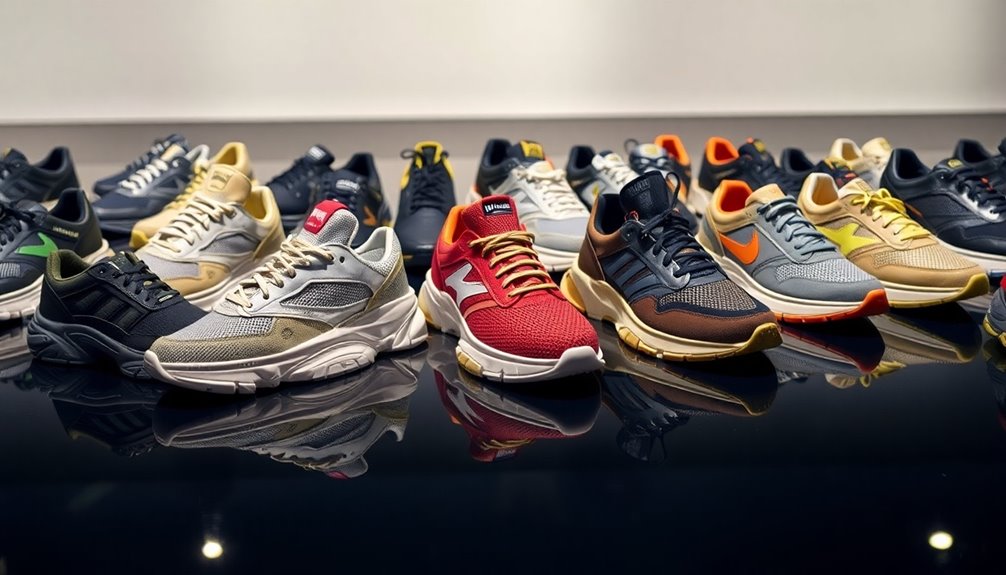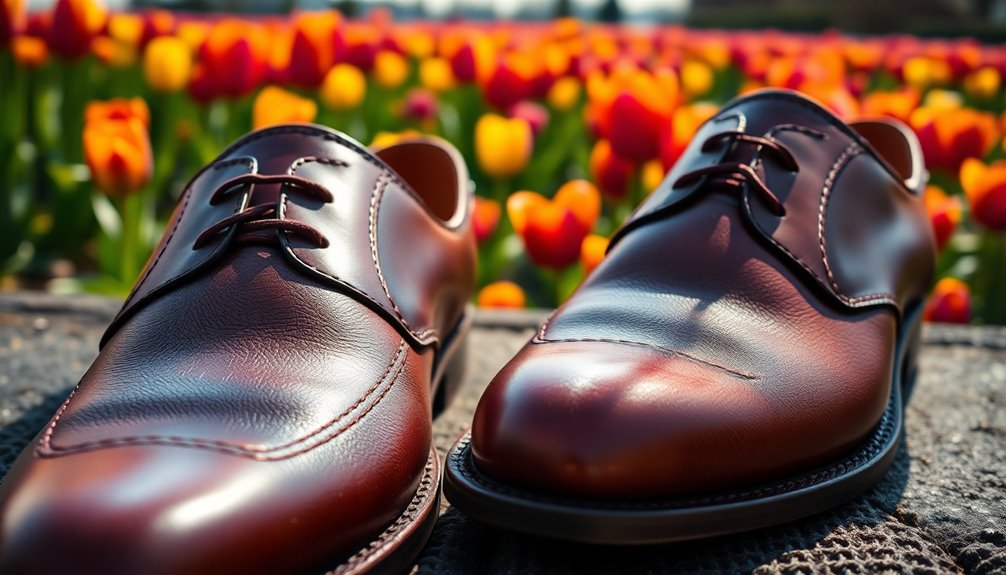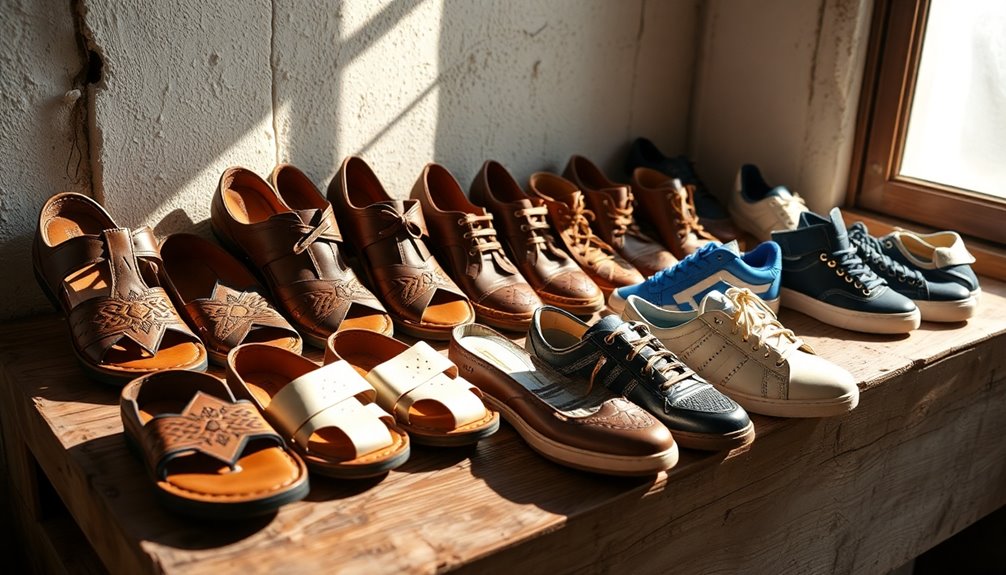If you're exploring Dutch shoe brands, you'll find a dynamic market rich in hidden gems. Established names like Floris van Bommel and Fred de la Bretoniere showcase exquisite craftsmanship and strong designs. But don't overlook emerging brands like Filling Pieces, which mixes streetwear with high fashion, or Loints of Holland, known for eco-friendly options. With sustainability gaining traction, many brands are prioritizing ethical practices. The market is evolving, driven by younger consumers seeking comfort and style. There's so much more to discover within this vibrant footwear scene, so keep going to unearth even more unique insights about these impressive brands!
Key Takeaways
- Filling Pieces combines streetwear aesthetics with high fashion, appealing to a younger, style-conscious demographic in the Dutch market.
- Daily Paper celebrates African heritage through bold and unique footwear designs, catering to consumers seeking cultural representation.
- Wolky emphasizes comfort and sustainability, attracting eco-conscious customers looking for stylish yet comfortable footwear options.
- VAN LIER promotes craftsmanship with vegan options and eco-friendly packaging, appealing to consumers prioritizing ethical fashion choices.
- Emerging brands like Pop Trading Company and Komrads innovate by blending functionality and sustainability, capturing the attention of a diverse audience in the market.
Overview of the Dutch Footwear Market

As the Dutch footwear market continues to evolve, it reached a robust $2.4 billion in 2023, reflecting a 1.6% growth from the previous year. This growth follows a period of fluctuation, particularly from 2016 to 2020, when the market experienced a slight decline.
However, since then, total consumption has steadily increased, peaking in 2023, with expectations for gradual growth in the near future. Additionally, the market's Herfindahl index has decreased, indicating an increase in competition among footwear brands.
In terms of production, footwear manufacturing in the Netherlands has shown resilience, with exports rising for four consecutive years by 2023. Despite a dip in imports that year, the overall import volume has grown at an average annual rate from 2012 to 2023.
The market is segmented by type, material, and end-users, with women's footwear commanding a significant share of the market.
Distribution channels play a crucial role, with online stores and supermarkets gaining traction. The competitive landscape is evolving, as indicated by a slight decrease in the Herfindahl-Hirschman Index, showcasing a move towards a more competitive environment.
Key Players in Dutch Footwear
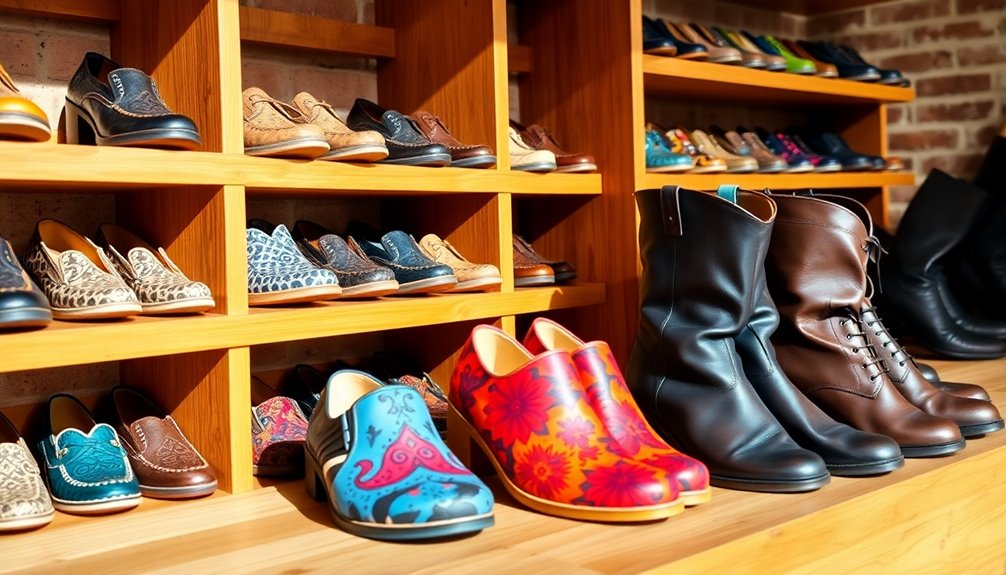
The landscape of Dutch footwear is shaped by a mix of established brands and innovative newcomers, each carving out a unique niche in the market. Key players like Floris van Bommel, founded in 1734, exemplify high-quality craftsmanship, remaining a family business in its 9th generation.
Fred de la Bretoniere, established in 1970, appeals to women with strong, self-assured designs. Another standout, Loints of Holland, has focused on eco-friendly, durable shoes since 1918, using high-quality German leathers. Additionally, many of these brands are recognized for their high-quality footwear, which enhances their appeal to consumers looking for durability and style.
With a market size of €138.3 million in 2024, the Dutch footwear industry features 147 businesses. It's expected to grow over the next five years, fueled by online orders and customization trends.
Brands like ETQ Amsterdam and Nubikk are pushing boundaries; ETQ offers minimalist sneakers while Nubikk targets young adults with luxury designs.
While no single company dominates, brand recognition drives market concentration amidst moderate competition. These players maintain their positions through quality, innovative designs, and effective marketing strategies.
As international trade continues to influence the market, these key players remain crucial in defining the Dutch footwear landscape.
Emerging Local Shoe Brands
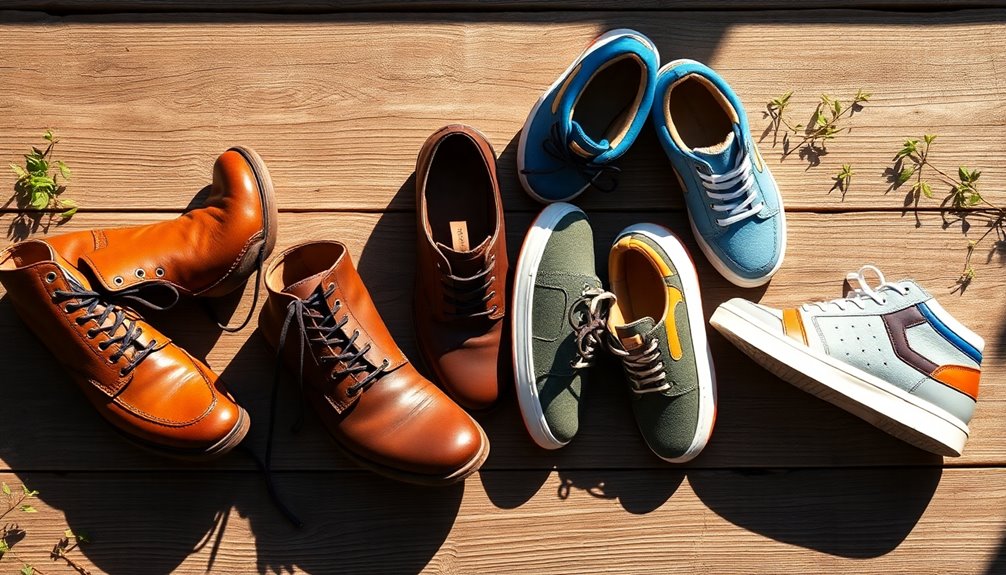
A growing number of innovative local shoe brands are reshaping the Dutch footwear scene, each bringing unique styles and a commitment to quality.
Take Filling Pieces, for instance. Based in Amsterdam, they're known for avant-garde footwear that merges streetwear with high fashion, focusing on unconventional silhouettes and meticulous craftsmanship. This aligns with the broader trend of Dutch fashion being recognized for its forward-thinking mindset and commitment to quality.
Then there's Daily Paper, which celebrates African heritage through bold prints and vibrant colors, collaborating with notable names like J. Cole's Dreamville.
Pop Trading Company emerges from Amsterdam's skate scene, combining functionality with contemporary design, appealing to both skaters and fashion enthusiasts.
When it comes to comfort and sustainability, brands like Wolky shine with their nature line featuring cork and memory foam insoles.
Meanwhile, VAN LIER emphasizes craftsmanship, recently launching a vegan sneaker and shifting to eco-friendly packaging.
ETQ Amsterdam offers minimalist sneakers at competitive prices, while Nubikk targets luxury consumers with high-quality materials and trendy designs.
Each of these brands not only enhances your shoe collection but also reflects the rich diversity and innovative spirit of the Dutch footwear market.
Market Dynamics and Trends

In 2023, the Dutch footwear market reached an impressive $2.4 billion, reflecting a steady growth trajectory that's been consistent since 2012.
You've likely noticed the market's 1.6% increase compared to the previous year and the significant rise in consumption over the past eleven years. Footwear consumption peaked in 2023, and it's expected to continue its gradual growth in the near future. Notably, the average annual growth rate of X% has been observed from 2012 to 2023, showcasing the market's resilience.
On the production side, the Netherlands experienced a resilient increase, with production peaking in 2023 and showing signs of steady growth ahead.
Exports saw a record high, marking the fourth consecutive year of growth, despite some fluctuations in the earlier years. Interestingly, imports decreased in 2023 after a two-year rise, showing the market's volatility.
Retail trends reflect a shift toward second-hand items, driven by affordability and eco-friendliness.
You might've noticed that major international brands are consolidating their influence, while retailers invest in omnichannel experiences to enhance customer engagement.
Even with a slight dip in consumer confidence, the growing population, fueled by immigration, supports an expanding consumer base that will continue to shape the market dynamics.
Consumer Preferences and Segmentation

Consumer preferences in the Dutch footwear market reveal a strong inclination toward brand loyalty, particularly for premium labels. A significant share of consumers opts for high-end brands like Nike and Adidas, showcasing a preference that stems from brand awareness, quality, and prestige. In fact, many consumers prioritize well-known brands over private labels due to this loyalty.
Demographic segmentation plays a crucial role here. Young consumers aged 18 to 35 are a key target group, heavily influenced by comfort, style, and sustainability practices. This age group's growing interest in vintage and second-hand items indicates a shift toward eco-friendliness and unique fashion statements, aligning with their values. Notably, the increasing acceptance of private label brands among consumers highlights the evolving landscape of brand preferences.
Purchasing behavior also reflects a careful approach, as Dutch consumers become increasingly prudent with their spending. They seek affordability alongside style, which has sparked interest in second-hand and vintage footwear.
While online shopping convenience is essential, many consumers equally value in-store experiences, leading retailers to adopt omnichannel strategies to meet these preferences. In this dynamic landscape, understanding consumer preferences and segmentation is vital for brands aiming to resonate with the Dutch market.
The Role of Sustainability
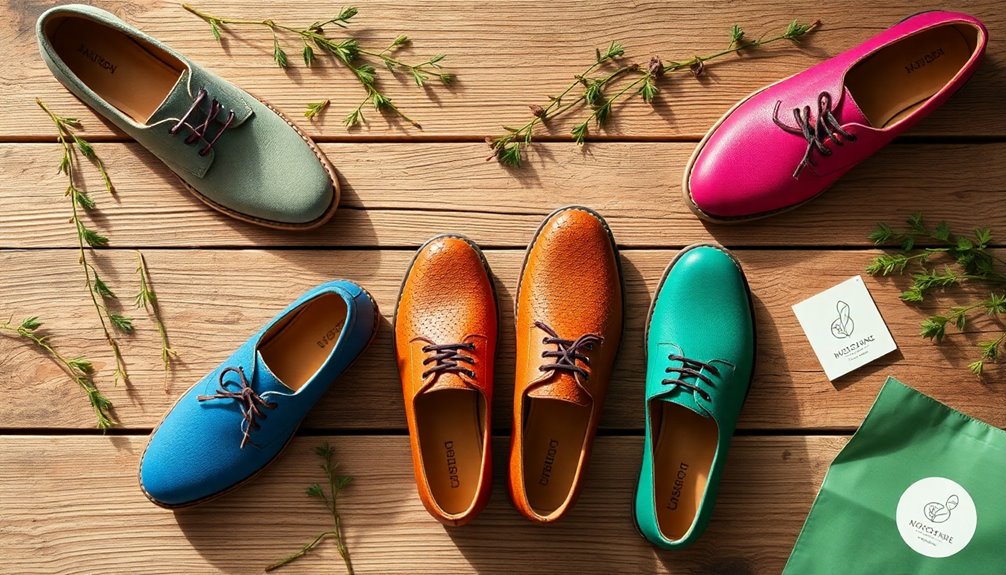
Sustainability plays a pivotal role in shaping the Dutch shoe market, as brands increasingly adopt eco-friendly practices to meet consumer demands.
You'll find that many brands, like Loints of Holland, prioritize high-quality leathers free from harmful chemicals, ensuring a more ecological production process. Veja stands out with its sustainable sneaker options, offering both minimalistic leather and a completely vegan range.
Recycling is another key focus, with companies like Komrads using recycled rubber and plastics, while Indosole repurposes old car tires for beachwear. Sustainable materials are essential for reducing waste and promoting a circular economy, and Norm takes it a step further by employing up to 90% recycled materials and promoting transparency in their production.
Circular economy practices are gaining traction, too. Brands like Langbrett and Viron implement take-back services and closed-loop systems, ensuring their products can be remade into new items.
Energy consumption is also addressed; Norm offsets carbon emissions by planting trees in Madagascar.
Ethical practices are integral as well. Ethletic leads with Fairtrade certification, ensuring fair labor, while Veja supports sustainable agriculture.
Through these efforts, Dutch shoe brands aren't only meeting consumer expectations but also paving the way for a more sustainable future.
Distribution Channels Explained
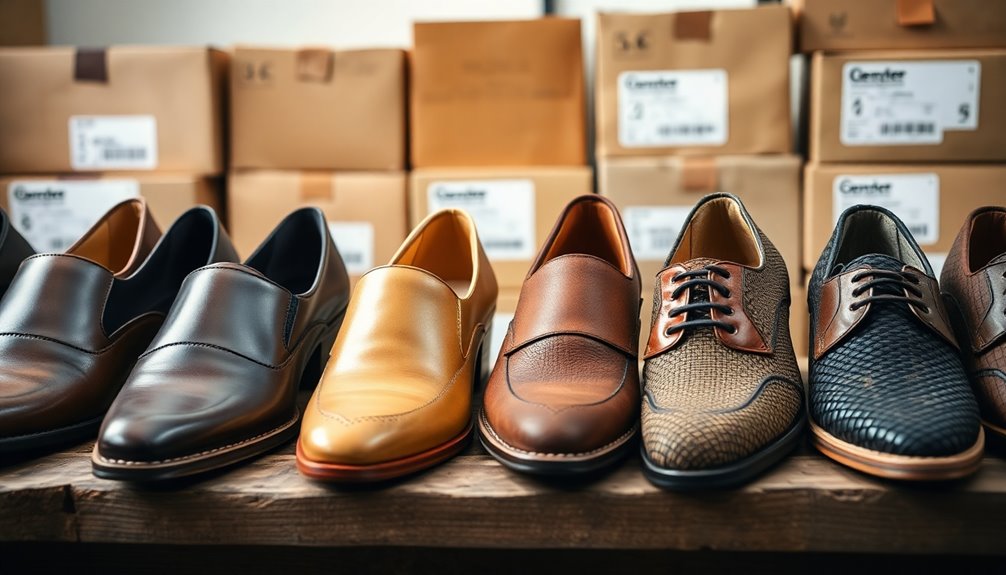
As Dutch shoe brands embrace sustainability, they're also redefining how they connect with customers through various distribution channels. Brick-and-mortar stores still dominate, capturing 75.6% of revenue in 2023. Boutique shops and independent luxury footwear stores adapt quickly to fashion trends, offering exclusive deals that attract discerning shoppers.
However, as consumer preferences shift toward online shopping, physical retail faces challenges. Online channels are gaining momentum, with platforms like Zolando, Coolblue, and Sarenza leading the charge. The popularity of e-commerce provides greater product availability and expands the distribution network. Moreover, BIRKENSTOCK's new distribution strategy allows for more direct engagement with consumers, enhancing brand presence.
Furthermore, mobile commerce accounts for 30% of online transactions, making it vital for brands to enhance their digital presence. Direct-to-consumer (DTC) channels are also on the rise, with brands like Birkenstock and HOKA focusing on developing a seamless online and offline experience.
These channels allow for deeper customer relationships and personalized interactions, reinforcing brand loyalty. Lastly, wholesale distribution remains important, as brands like Birkenstock take control of their distribution to enhance quality.
Challenges Facing the Industry
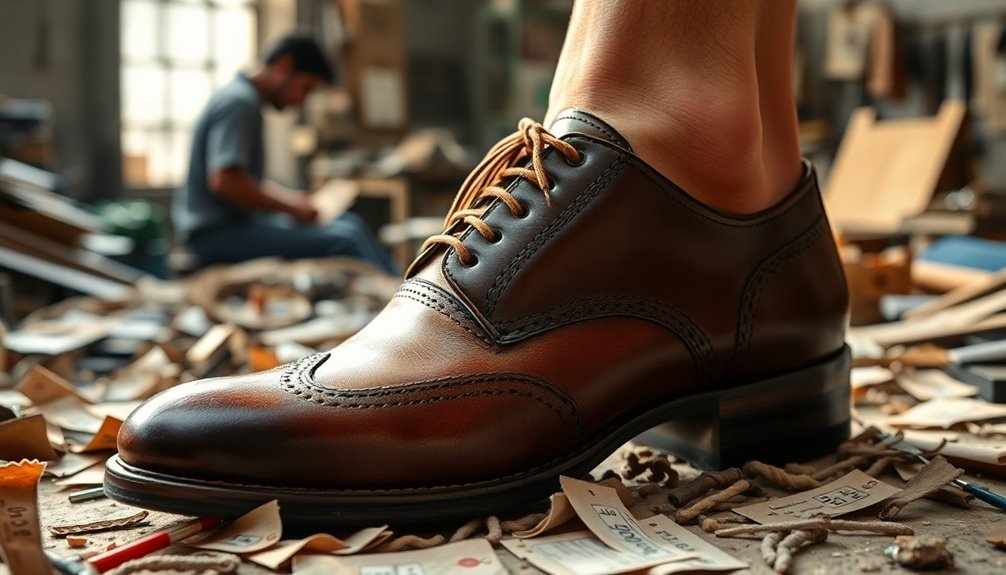
Facing a multitude of challenges, the Dutch shoe industry grapples with significant environmental, market, and regulatory pressures. One major concern is the high CO2 footprint of production, where 70-90% of the total impact occurs in the manufacturing phase.
With an average of 7 to 11 kg CO2-eq per pair of shoes, brands must innovate to reduce waste, as approximately 10% of new shoes end up being destroyed. The production phase accounts for a substantial portion of environmental impact, which means brands must prioritize sustainable practices.
Market-wise, the footwear sector is shrinking, with a projected decline of 5.6% CAGR from 2019 to 2024. This contraction in revenue, alongside rising raw material costs and cautious consumer spending, creates a tough environment for brands, especially new entrants facing high barriers to entry.
On the regulatory front, compliance with stringent quality and sustainability standards adds another layer of complexity. The Extended Producer Responsibility encourages manufacturers to focus on reuse and recycling, further straining resources.
Plus, changing consumer preferences toward second-hand and athleisure styles push brands to adapt quickly. In this challenging landscape, it's crucial for Dutch shoe brands to navigate these hurdles effectively to thrive.
Future Outlook for Dutch Brands

The Dutch footwear market is projected to reach a valuation of USD 2.49 billion by 2025, driven by a growing demand for stylish, high-quality products. As disposable income rises and the labor market improves, you'll find more purchasing power among consumers. Urbanization and a robust online presence will also push sales through digital channels, making it easier than ever for you to shop. This market growth is primarily influenced by urbanization and rising disposable income.
Additionally, the rise of e-commerce trends is transforming how consumers engage with brands, enhancing accessibility and convenience. Expect increased competition among brands, leading to product innovation and enhanced research and development efforts.
Online shopping is set to thrive, with over 92% of the population connected to the internet, while offline channels will still play a vital role for spontaneous purchases and inspiration. Brands are adopting an omnichannel approach, catering to your preferences for both online convenience and in-store experiences.
Sustainability will be at the forefront, as brands like Adidas and Nike implement eco-friendly initiatives. Expect to see innovative designs and sustainable materials, appealing to your growing interest in responsible consumption. As a young consumer, you'll likely prioritize these values, alongside product quality, shaping the future landscape of Dutch footwear brands.
Frequently Asked Questions
What Are the Most Popular Shoe Styles Among Dutch Consumers?
When it comes to popular shoe styles among Dutch consumers, you're likely to see a mix of traditional and modern options.
Klompen, or wooden shoes, remain a cultural staple for their historical significance.
However, many people also gravitate towards high-quality brands like Floris van Bommel for men or Fred de la Bretoniere for women.
Sneakers, especially minimalist styles from ETQ Amsterdam and Nubikk, are also trending, reflecting comfort and contemporary fashion preferences.
How Do Dutch Brands Compare to International Brands in Quality?
When you compare Dutch brands to international ones, you'll find that Dutch brands often emphasize quality materials and eco-friendly practices.
Brands like ETQ and Filling Pieces use high-quality materials while maintaining affordability. In contrast, international brands like Crockett & Jones focus more on craftsmanship, which can come with a higher price tag.
Ultimately, if you're seeking durability and sustainability at a reasonable price, Dutch brands might be the better choice for you.
What Influences the Pricing of Footwear in the Netherlands?
The pricing of footwear in the Netherlands is influenced by several factors. Rising raw material costs, driven by global trade issues and inflation, directly impact expenses.
You'll notice a shift towards sustainability, with consumers demanding eco-friendly options, which can also raise prices.
Additionally, online shopping trends and customization options are shaping market dynamics.
Lastly, competition among brands and regulatory pressures play significant roles in determining how much you'll pay for your shoes.
Are There Any Government Regulations Affecting Footwear Manufacturing?
Yes, there are several government regulations affecting footwear manufacturing.
You'll find mandates like the Berry Amendment, requiring certain federal agencies to source domestically.
The Consumer Product Safety Commission oversees safety standards, especially for children's footwear, ensuring compliance with regulations like the CPSIA.
Additionally, labeling requirements, both in the U.S. and EU, dictate how materials must be disclosed.
These regulations aim to enhance safety, support domestic production, and ensure transparency in the market.
What Role Do Fashion Trends Play in Dutch Footwear Choices?
Fashion trends play a significant role in your Dutch footwear choices. You likely find that styles like dad sneakers and Adidas Sambas dominate your wardrobe, reflecting both comfort and current trends.
Social media influences your decisions, showcasing popular looks that inspire you. Plus, the cultural emphasis on sustainability encourages you to choose eco-friendly materials, blending style with responsibility.
Ultimately, your footwear choices express your personal style while staying attuned to the latest trends.
Conclusion
In conclusion, the Dutch footwear market is thriving with a blend of established players and emerging brands that cater to diverse consumer preferences. As sustainability takes center stage, you can expect innovative designs and eco-friendly practices to shape the future. By staying informed about market dynamics and challenges, you'll appreciate the unique offerings from these hidden gems. So, whether you're shopping for style or sustainability, Dutch brands have something special waiting for you.
